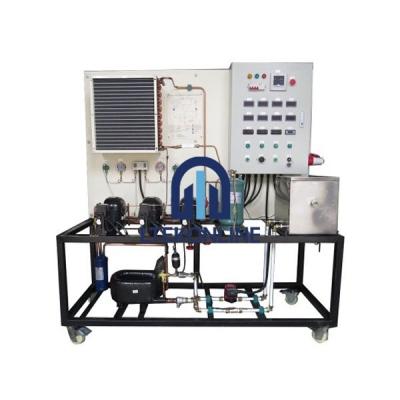Tenders Description & Specification for Energy Efficiency in Refrigeration Systems
Energy Efficiency in Refrigeration Systems
Learning Objectives / Experiments:
Methods for returning oil in a multi compressor refrigeration system
Representation of the thermodynamic cycle in the log p-h diagram
Variables affecting energy efficiency
Interconnected operation of compressors
Operation of a multi compressor controller
Controller parameters
Refrigerant super cooling.
Specification
Refrigeration circuit with 3 compressors connected in parallel, condenser, thermostatic expansion valve and coaxial coil heat exchanger as evaporator
Heat exchanger for refrigerant supercooling can be added via valves
Multi compressor controller for the parallel operation of the compressors
Separation of oil from the refrigerant on the delivery side and return to the intake side of the compressors
Refrigeration system in multi compressor operation to investigate energy efficiency
Glycol-water circuit includes pump and tank with heater serving as cooling load at the evaporator
Fan at the condenser with adjustable speed
Refrigerant R134a, CFC-free.
Technical Data:
3 compressors
Refrigeration capacity: each 1584W at -10°C/55°C
Power consumption: each 1156W at -10°C/55°C
Condenser with fan
Air flow: 1250m³/h
Capacity: 4100W
Coaxial coil heat exchanger capacity
4kW at ΔT=9K; 0,6m³/h glycol-water mixture
Glycol-water mixture pump
Max. head: 6m
Heater power: 3kW
Max. flow rate: 5m³/h
Tank
Refrigeration circuit receiver: 5,8L
Glycol-water mixture: 23L
Measuring ranges
Pressure: 1x -1…9bar, 1x -1…24bar
Flow rate: 1x 1..25L/min
Temperature: 4x 0…100°C, 4x -100°C…100°C
Compressor power: 0…4995W
Connections
400V, 50/60Hz, 3 phases
Dimensions and Weight
L x W x H: 1800x700x1900mm
Weight: approx. 300kg
Ltekonline are the manufacturers of Energy Efficiency in Refrigeration Systems used to demonstrate engineering principles in Engineering Colleges, Engineering Schools and Thermal Training Equipment for Engineering Teaching Lab in Universities
